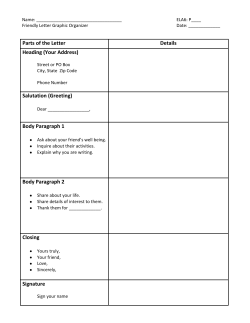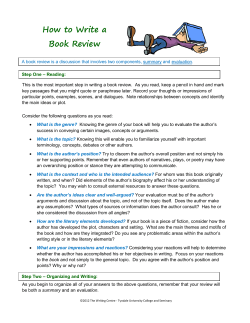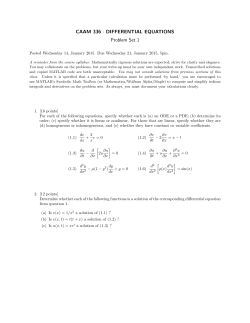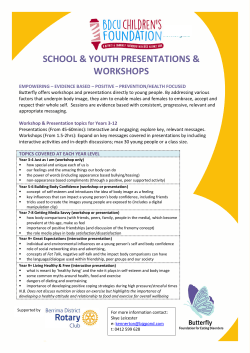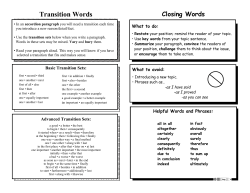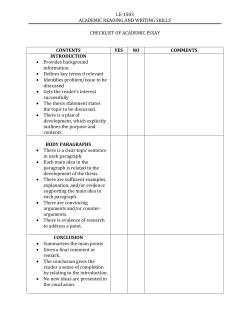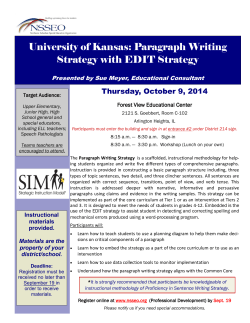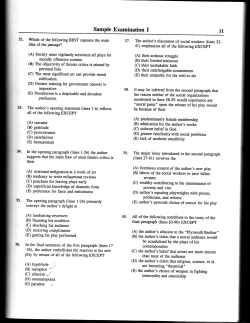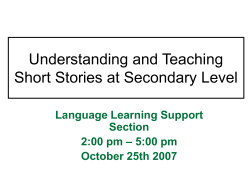
Tips & Hints for Figures, Writing & Presenting
One Person’s View About How to Write a Great Scientific Report & Make a Better Presentation ChE130 (Spring 2015) Last Update: April 1, 2015 In ChE130 in Spring 2011, I presented some of these topics in a one-hour chalk talk. At the end of that term, many students said they wished they had a document for that lecture. Based on that presentation – and after reviewing many past reports and presentations – I’ve compiled this compendium of helpful hints for reports and presentations. It’s a fourth draft for Spring 2015, and I will improve it in the future. OVERVIEW When writing or presenting, you should strive to be clear, complete, concise, and correct. You’ll often find a trade-off between completeness and conciseness, and you need to find a happy medium that conveys all of the necessary information and background to your audience without deluging them with unnecessary details. Always ask yourself, “Is this paragraph relevant and necessary for my overall story?” If it’s not, then you should remove it. You should ask yourself, “Is this sentence relevant and necessary for the major point of this paragraph?” If it’s not, then you should remove it. You should ask yourself, “Is this word (or phrase) relevant and necessary for the major point of this sentence?” If it’s not, then you should remove it. Before you begin writing, identify the big picture and takeaway message(s) that you want your audience to remember. You shouldn’t have more than a few major takeaway messages for the length of the written report and for the duration of the oral presentation in this class. Think about what you want your audience to say when others ask them, “What was that talk/report about?” You should identify a clear message and reinforce that message throughout your writing and your presentation. Write papers by focusing on the parts that your entire audience will read – the figures, the title and the abstract. There are three types of readers: novices, researchers, and experts. Novices are trying to learn about a new area and typically read the paper from abstract through conclusions, in order, mainly paying attention to the title, abstract, introduction and figures. Researchers are trying to replicate somebody else’s work and are usually vaguely familiar with the research area; they read the title and abstract to determine if they should bother reading the paper, and then focus on the methods section and the figures to compare their own results. An expert – someone like your adviser – doesn’t spend a significant amount of time on any one paper, which means experts read the list of authors, the title, maybe the abstract and only look at figures and their captions. Even though they may read papers for entirely different reasons, each person looks at the figures, the title and the abstract. Since everybody looks at your figures – and since you’ll use figures in both written reports and presentations – you should identify which figures best tell your story and convey your takeaway messages, while requiring only short captions for reports or a few spoken words for presentations. You should identify one figure as the primary result, and spend time making that centerpiece figure a masterpiece. You can often accomplish this feat by creating a storyboard, like writers do for TV series and theatrical films, especially for animation. Writers put together a series of images, with each image representing a major plot point or key scene. You should do the same with your figures to make sure that you have all key evidence to support the story you are telling, using your centerpiece figure as the story’s climax. 1 One Person’s View About How to Write a Great Scientific Report & Make a Better Presentation ChE130 (Spring 2015) Last Update: April 1, 2015 FIGURES If you are submitting your work to a journal that has clear specifications for figure attributes, including the aspect ratio, then you should follow that publication’s style. If you have good reason to deviate from that style, contact the editor or editor’s assistant for advice. The rest of this section deals with cases for which the figure attributes are not specified, while providing rules of thumb you can use to make your figures for journals even better while still following a publication’s stated style. Aspect Ratio The figure aspect ratio is the ratio between the horizontal length and the vertical length of a real (or imaginary) rectangle that encloses a figure in a publication or presentation. If the aspect ratio is too skewed, then you may be enhancing small differences without purpose, hiding important variations, or just making the plot difficult to read. In general, you can use the golden ratio to determine whether an aspect ratio is appropriate. The golden ratio, which is often used in art, architecture and book design, is an irrational fraction that has an approximate value of 1.618. To make your plots aesthetically pleasing, you should make sure that 1/1.618 < aspect ratio < 1.618. There are exceptions to this rule-of-thumb: • • In environmental science, scientists plot a quantity as a function of altitude (in air) or depth (in water). For these situations, writers often use skewed aspect ratios to better highlight the magnitude and range of linear distances. When researchers display multiple variables as a function of time and plot data for each variable on different graphs, they stack graphs on top of each other and use a much longer x-axis for time. Most often, scientists want to highlight multiple events that happened at different times and then compare and contrast the behavior of multiple measurements to these events. If possible, you should use the golden ratio for the rectangle that encloses all plots (or panels) in this single figure. Here’s one point of reference: most press sites for the television industry provide photographic images in a 300x200-pixel format for internet journalists and marketers. (Note that these images have an aspect ratio of 1.5.) 2 One Person’s View About How to Write a Great Scientific Report & Make a Better Presentation ChE130 (Spring 2015) Last Update: April 1, 2015 Number of Panels in a Figure For reports, you can include multiple panels in each figure. Each panel is a separate item, such as a plot, with its own label using (a), (b), (c), etc. that is clearly visible inside each plot. Each panel is referenced in the caption. Typically, you’ll use an even number of panels in a figure. If you do use an odd number of panels, you’ll often treat your caption as a panel. Typically, you’ll use no more than six panels in a figure. For presentations, you typically only have enough space to effectively present two figures simultaneously. These figures are typically side-by-side, but you can arrange figures to be up-and-down if you are presenting time series and want to show how an event simultaneously affects multiple measurements. If you are presenting graphs in an up-and-down configuration, you can sometimes add a third figure if your headline is short and near the top of the slide. 3 One Person’s View About How to Write a Great Scientific Report & Make a Better Presentation ChE130 (Spring 2015) Last Update: April 1, 2015 Plots When creating graphical plots of data, here are a few rules of thumb that are appropriate for both written reports and oral presentations: BACKGROUNDS All plots should have a white background since it provides the best contrast with symbols, lines and axes. Unfortunately, Excel usually defaults to a gray background. DO NOT USE THIS GRAY BACKGROUND IN YOUR PLOTS. Very rarely do we use gray backgrounds for scientific graphs. TITLES For reports, your plots do not need titles above the figure. You’ll include the plot title in your caption. For presentations, your plot title should be the slide heading/title. If you use both a slide title and a plot title, you’re using too much real estate at the top of the page, leaving less room for your plot below it. There are some cases when you will use the slide heading/title for a general plot title when (a) there are two plots per slide and (b) the plot titles each include only one or two words. For instance, you may use a slide title such as “The Effects of Caffeine on Lab Safety” and use plot titles of “Without Caffeine” and “With Caffeine.” In this case a plot title can be placed above the graph or inside the graph. AXES All axes should be labeled with a title and, if necessary, appropriate units. In some cases, you may even include a note that a quantity is dimensionless. TICK MARKS All axes should have major tick marks, and each major tick mark should have a label/number. Make sure the font and font size are appropriate for each label/number. For reports, check the journal’s style. For presentations, make sure that the text is large enough that the person sitting in the back of the room doesn’t have to squint, but make sure that the text isn’t so large as to dominate the graph. One of the most common complaints about presentations is that the audience couldn’t read the numbers and labels on plot axes. Typically, you’ll use no more than five major tick marks between the endpoints of an axis. You should choose the number of major tick marks so that each axis label has an easy to read number. A major tick mark should not have a label like “0.317,” but “0.300” might be appropriate. Minor tick marks are optional. Minor tick marks are not labeled. When submitting to a journal, check the publication’s style to check whether the tick marks should be inside, outside, or inside/outside. For this class, you may use any style you want. For presentations, the style is your choice. 4 One Person’s View About How to Write a Great Scientific Report & Make a Better Presentation ChE130 (Spring 2015) Last Update: April 1, 2015 SYMBOLS • • • • • • • • • Always include a legend. For presentations, your legend should be either: (a) in a large white space inside your plot with a box around the legend to differentiate it from points on the plot OR (b) outside the plot to the right if the text labels are short or along the bottom if the text labels are long. For written reports, you should consult the publication’s style, but for this class you may include a legend as described for presentations OR include it as part of the caption. Use solid/filled symbols whenever possible. Solid colors are easier to see, photocopy better and are compressed with little loss in resolution. If you must use an open symbol, use a thick solid line for the outline, while leaving enough white space for the fill. Use a single color for symbols. Don’t use one color for the symbol outline and a second color for the fill color. Choose colors carefully. Use colors that are easy to differentiate from each other and easy to see on their own. Don’t use light colors, like yellow. Don’t use red and green next to each other – be kind to people in your audience who are color blind. Always look at your plot in black-and-white. It’s expensive to publish a color graph in a journal, and even though you use a graph with color symbols in a presentation, it’s quite likely you’ll use the same plot in a journal. Plus, somebody may get a black-and-white copy of your presentation. Use a single size for all symbols. Don’t use the same symbol and change its size to represent different treatments or values of parameters, UNLESS THE DIFFERENCE IN SYMBOL SIZE IS SIGNFICANT AND ONLY REPRESENTS TWO – OR AT MOST THREE – TREATMENT LEVELS. (In business-related plots, you’ll often see the symbol size represent a continuous variable, but we don’t often use them in scientific reports.) When plotting multiple data sets on a single plot, use a single feature to represent a value of a parameter (or an attribute) that doesn’t change. For example, use triangles, squares, circles and diamonds to represent four different operating temperatures. Then, use filled symbols for all data acquired using treatment A and open symbols for data acquired using treatment B. Then, use different colors to represent a third parameter, such as pH. By following this method, you can easily get your audience to focus important features for each trend you identify. Use the same symbols to represent the same treatments or parameters throughout your entire work, if at all possible. Don’t use more than eight types of symbols – geometry; filled/open; color – on the same plot. If you use more than eight, you’ll lose your audience during a presentation; simply split your data into multiple plots with each graph having a very specific purpose. If you want to have a summary slide at the end with all of your data, especially if you presented a way to collapse many data sets onto a single line, then you may do that – but don’t include a legend. 5 One Person’s View About How to Write a Great Scientific Report & Make a Better Presentation ChE130 (Spring 2015) Last Update: April 1, 2015 LINES In addition to plot axes and major and minor tick marks, you should use lines on graphs in the following situations: • • • • • • Any equation, including theoretical models, empirical correlations, or asymptotic results. Curve fits, when using an appropriate model to fit the data. (Don’t just choose a model that looks like it fits the data. You should have a scientific reason for the functional form of the equation used for the curve fit.) Rejection regions or confidence intervals. Specifications, control limits or set points. Identifying regions of behavior. Error bars. Except error bars, each line should have its own label, and that label can be on the plot or part of a legend. You should use the same style line for the same entities – for instance, use dashed lines for asymptotic results and solid lines for theoretical models – throughout your report or presentation. There are rare occasions when you use a line to connect points in a data set to help guide the viewers’ eyes. If you plot multiple sets of data on a single graph and if a trend or feature is not clearly visible, you may use lines to connect points in as many data sets as necessary to make that feature or trend obvious. (Connect the symbols with straight lines; don’t perform a curve fit.) When using lines for this purpose, use as few lines as possible and make it clear why you are using these lines. If you use too many lines and they cross each other too much, then your point will be lost. 6 One Person’s View About How to Write a Great Scientific Report & Make a Better Presentation ChE130 (Spring 2015) Last Update: April 1, 2015 ERROR BARS Ideally, on a plot of processed data, each point should have its own error bar. For time-sensitive lab courses and for many difficult experiments, you may include error bars for only a few points on a graph to indicate the magnitude of error for various sets of treatments and conditions. For plots of raw data – often as a function of time – you don’t need to include error bars. To estimate the values for error bars, you may use: • • • Standard deviation: If you have multiple measurements for a single set of conditions or are calculating the average value of a time-series of data, you can use standard deviation as an indication of error. You may use ± one or two standard deviations. State your choice. Confidence interval: You may use your measurement of variance and calculate a suitable confidence interval, based on the underlying distribution of data. Note that these techniques vary, depending whether or not the data is normally distributed. You may use 90% or 95% confidence intervals. State your choice. Propagation of uncertainty: If you use an equation to calculate a derived quantity, then you should use this method. Remember, each of your underlying measurements has some uncertainty associated with it. For instance, if you calculate concentration, c, after adding a measured mass of polymer, m, to a measured volume of solvent, V, then concentration is a derived quantity using the equation c=m/V. You also know that each underlying measurement, mass and volume, has some uncertainty associated with it. That uncertainty or variability is caused by one or more of the following: the resolution of the measuring device; the user’s ability to read a result from the measuring device; the user’s ability to follow a procedure to make a measurement using the measuring device; accuracy and calibration of the device; and sample variability. You should be able to assess or measure the uncertainty in each of the primary measurements: polymer mass and sample volume. But how do you calculate the uncertainty of the derived quantity? 𝜕𝜕 𝜎𝑓 = � � � 𝜎𝑖 𝜕𝑥𝑖 where f is a function that is calculated from measured quantities xi, and σi is the standard deviation or uncertainty of measured quantity xi. For the example of polymer concentration in a polymer solution, c=m/V, you can calculate uncertainty in concentration this way: 𝜎𝑐 = � 𝜕𝜕 𝜕𝜕 � 𝜎𝑚 + � � 𝜎𝑉 𝜕𝜕 𝜕𝜕 1 𝜎𝑐 = � � 𝜎𝑚 + |𝑚|𝜎𝑉 𝑉 7 One Person’s View About How to Write a Great Scientific Report & Make a Better Presentation ChE130 (Spring 2015) Last Update: April 1, 2015 𝜎𝑐 𝜎𝑚 𝜎𝑉 = + 𝑐 𝑚 𝑉 When evaluating σm and σc in this situation, you can’t use standard deviation since you only measured the polymer mass and solvent volume once each. You must estimate the uncertainty in your measurement, based on typical variance associated with that measurement method or one-half of the smallest increment/digit. For pipettes, manufacturers specify a value for uncertainty for different ranges of volume for a given model number. If your equation includes a physical property, such as gravity, then that quantity also has some uncertainty associated with it, and you must treat it like a variable in the above equations for propagation of uncertainty. Regardless of which method you use, you must identify your technique. In presentations, you should have a little note at the bottom of the slide or near the top of the x-axis. In reports, you should include a single, short sentence in your caption. Sometimes the error/uncertainty bars span a range that is smaller than the size of a symbol. If that’s the case, include a note in your caption that indicates which data points have calculated error bars that are not visible. This step is important since you are letting your reader know that you addressed the potential effects of error/uncertainty and immediately gives you additional credibility. In a presentation, just tell your audience about these points. 8 One Person’s View About How to Write a Great Scientific Report & Make a Better Presentation ChE130 (Spring 2015) Last Update: April 1, 2015 FIGURE CAPTIONS If you are submitting your work to a journal that has clear specifications for figure captions, then you should follow that publication’s style. If you have good reason to deviate from that style, contact the editor or editor’s assistant for advice. For instance, some journals require that you use only standard text in captions, while other publications may allow special symbols. Your caption should follow the general rule about being clear, concise, complete, and correct. Conciseness is more important than completeness since you have limited space for captions, but the captions should be complete enough that the reader can understand your point by just looking at the figure and reading the associated caption. Remember, your adviser won’t actually read the article unless figures and their captions present a compelling enough story. Your boss doesn’t have time to read everything, and generally just looks at pictures. For this course, each caption should have the following format: Figure #. Caption Title. Caption text. Figures are numbered consecutively as they are referenced in the text. The number is an Arabic number. “Figure #” is in regular bold text. The caption title should be no more than ten words. The caption title is shown using title case, with the first letter of each important word in uppercase and the remaining letters in lowercase. “Caption Title” should be in italics text. The caption text is in paragraph case, with the first letter of each sentence in uppercase. The caption text includes complete sentences. “Caption text” should be in regular text. All parts of the figure caption use the same font style and the same font size. The total length of the caption, including the title and the text, should be no more than seven lines of text. 9 One Person’s View About How to Write a Great Scientific Report & Make a Better Presentation ChE130 (Spring 2015) Last Update: April 1, 2015 WRITTEN REPORTS Now that you’ve identified the appropriate figures – and written their captions – you’ve already outlined your report. In this section, I’ll remind you of a few key points about writing. I’m going to break this discussion into multiple parts, with each focusing on a different aspect: sections; paragraphs; sentences; and words. By Section You are generally trying to answer a few key questions in each section of a typical report: • • • • • • Abstract: A short overview of each section, including quantitative results whenever possible. If you are using regular font/spacing, the abstract should be no longer than one-half page. Introduction: What did you accomplish? How does it fit in the field? Why is it important? Methods: What did you do, including critical items you used? For critical items, such as equipment and raw materials, you should include the name of the manufacturer and the part/product number. You do not need to include the lot number in your report unless you have a specific reason for doing so. I should not see a numbered/bullet list with all of the steps – you are not writing a standard operating procedure. This section should not comprise the bulk of your report. Results: WHAT did you find? If this section is separate from discussion, then you should not discuss why something happened. Discussion: WHY/HOW did things happen? Don't just say when variable x increased, variable y also increased. That statement is a discussion of what happened; not WHY. Think about underlying mechanisms, interaction energies, or anything else at the microscopic level that may yield the same collection of macroscopic measurements. Conclusion: Brief recap, including quantitative results. 10 One Person’s View About How to Write a Great Scientific Report & Make a Better Presentation ChE130 (Spring 2015) Last Update: April 1, 2015 By Paragraph The first paragraph of each section should be a transition from the previous section, an introduction to the current section, and an overview of the section. If I just read the first paragraph of each section, I should have a good sense of your story – without the details. The first sentence of each paragraph should be a topic sentence. If you are an adept writer, you can make the topic sentence the last sentence of each paragraph. Regardless of its location, each paragraph should have a topic sentence – the main point of the paragraph – and all other sentences support the statement in, or premise of, the topic sentence. When you read a paragraph, you should ask yourself whether each sentence is relevant and necessary. Ideally, every sentence in the same paragraph has the same tense. (Even more ideally, most sentences in the same section have the same tense.) You may change the verb tense once in a paragraph, but if you find you’re switching verb tenses back and forth, you either (a) are mixing two arguments together and you should write two paragraphs or (b) just not being consistent. If a paragraph is longer than two-thirds of a page, you should consider splitting it into two paragraphs. It may truly be one paragraph – and then you should keep it as a single paragraph – but you should check. 11 One Person’s View About How to Write a Great Scientific Report & Make a Better Presentation ChE130 (Spring 2015) Last Update: April 1, 2015 By Sentence Keep the subject and the verb close together: When you place multiple prepositional phrases, adverbs and other clauses between a subject and the verb, the result is confusing because it’s often not clear who or what is performing the action. Make sure the subject and predicate agree: If your subject is plural, your verb should be plural. Likewise, if your subject is singular, your verb should be singular. These statements sound obvious, but so many students make this mistake. Usually, it’s clear whether your predicate should take its singular or plural form. Unfortunately, there are words like group and family, for which it is unclear and depends on context. If you talk about the group acting as a whole, then ‘group’ is singular. If you talk about the group acting as individuals, then ‘group’ is plural. Make objects/modifiers very clear: When using words like ‘this’ and ‘it’ by themselves, readers may not quickly understand what you write; instead, you should use ‘This _____’ so that _____ is a noun. Make sure that words like ‘it’ appear close to the object to which it refers. Use active voice, not passive voice: Active voice is much easier to read because the verbs are dynamic and because you’ll be more concise. I should not read many sentences that state “It was shown that…” I think younger writers find it easier to write concise sentences in active voice rather than passive voice. There are times when passive voice is more appropriate – because it emphasizes the result and not the person/items that caused that result – but we’ll leave that for another time. If you’re interested in a conversation about passive vs. active voice, I suggest you check out this Reddit AMA: http://www.reddit.com/r/askscience/comments/30x20y/askscience_ama_series_we_are_celia_elliott/ You may sparingly use first person: You may use ‘we’ or ‘I,’ but don’t start every sentence with those words. You’ll find you more frequently write concise sentences in active voice when using ‘we’ or ‘I’ by avoiding complex sentence structures. Also, the words ‘we’ or ‘I’ are more appropriate for the methods section – the section where you describe what you did – than they are for the discussion section. Avoid run-on sentences: If you write a sentence that is longer than three full lines, you’ve likely written a run-on sentence. While it’s true that you can write a properly constructed sentence to be of any length that you want, I typically find that students don’t properly use punctuation and connecting words appropriately to write a proper sentence longer than three lines. Avoid using more than four consecutive adjectives: If you use more than four consecutive adjectives to describe a noun in scientific writing, then you’re probably using too many nouns as modifiers and making it difficult for your readers to follow your writing. Avoid parenthetical statements: If you think the statement is important enough to include, then you should include it in the body of the paragraph. If the statement truly is not critical to make your point in that paragraph, then you can either eliminate it or reference it to a source material. 12 One Person’s View About How to Write a Great Scientific Report & Make a Better Presentation ChE130 (Spring 2015) Last Update: April 1, 2015 Be quantitative, not qualitative, whenever possible: Don’t just say that something ‘increased dramatically.’ The word ‘dramatically,’ while descriptive, is biased and inexact since it means different things to different people. That’s your opinion that it’s dramatic. You should instead be quantitative and say ‘increased by 500%.’ If you really want to convey to the reader that this number is dramatic, then you can say ‘increased by 500%, which is a dramatic difference compared to….’ In this case you’ve properly framed the comparison. Use assertion and speculation appropriately: When making claims, be sure to use an appropriate tone, based on quality and quantity of data to support a statement. 13 One Person’s View About How to Write a Great Scientific Report & Make a Better Presentation ChE130 (Spring 2015) Last Update: April 1, 2015 By Word Define abbreviations on first use in the body of the report: If you use an abbreviation, you must define it the first time you use it in the report. On subsequent uses, you can just use the abbreviation. For instance, first use ‘Principal Component Analysis (PCA)’ and ‘PCA’ for later uses. Choose abbreviations carefully – make sure they are unique and easy-to-understand. Don’t define an abbreviation if you don’t use it again. Don’t define an abbreviation in an abstract unless you use it multiples times in the abstract. If you define an abbreviation in the abstract, you must define it again in the body of the report. Always reports units for measurements: This statement seems obvious, but so many students report a value without units. Check every number. Check every column of every table to make sure you’ve included units in the column heading. Use the appropriate number of significant figures: When reporting values in the text or in tables, only use the appropriate number of significant figures. Write out counting numbers less than 10; use values for all continuous variables: You should write three flow controllers, 12 flow controllers, and a length of 3 inches. Length is a continuous variable – you don’t count inches since you can have fractions of inches – and you’ll always use numbers for continuous variables. You can’t have fractions of flow controllers; so that number is a counting number. Write out numbers that start a sentence: Regardless of the type of number, you should start a new sentence by writing out that number, or you can rewrite your sentence so that the number is no longer first. Example: “Fifteen hours earlier,….” is correct. “0.56 ml of benzene…” is not correct. In general, if you start a sentence with a non-counting number, you are writing in passive voice and you should rewrite the sentence. Use a leading zero for written numbers, if necessary: If a number has a decimal point and there are no non-zero numbers to the left of the decimal point, then you should add a leading zero to the left-hand side. Correct: “0.56 ml” Incorrect “.56 ml” Correct: “1.56 ml” Be careful with affect vs. effect: ‘Affect’ is a verb. ‘Effect’ is a noun. Use them appropriately. Use apostrophes correctly to indicate possession: So many students use apostrophes incorrectly – or don’t use them at all – making the word plural instead of possessive. If you use Word, that word processor does a reasonable job of identifying these issues. Be careful with “there,” “their” and “they’re” and similar words: Tools for checking grammar will almost always find issues with these words, but I still see students use the wrong word. 14 One Person’s View About How to Write a Great Scientific Report & Make a Better Presentation ChE130 (Spring 2015) Last Update: April 1, 2015 Use your word processor’s spell check and grammar check: These tools catch most common errors you’ll make, but there are many issues the checks won’t find. To find these additional errors, you should read each sentence backwards. When we read forward, our brain skips over words or adds words, as needed, so that the sentence makes sense. If you read text backwards, our brain can’t do that since there is no flow to the series of words. You’ll find some mistakes this way. Check for double words: One of the most common mistakes is typing the same word twice in a row. Grammar check usually finds the error, but you’ll often read right past the double word when you proofread. Check for homonyms that are the same part of speech: Grammar check will hardly ever find these. If you say that your data shows a peek at a time of 10.2 seconds, common wordprocessing tools will not find this error. You won’t find these issues proofreading either, since you’re reading quickly and your brain will put peak instead of peek. You might find the error reading backwards. 15 One Person’s View About How to Write a Great Scientific Report & Make a Better Presentation ChE130 (Spring 2015) Last Update: April 1, 2015 PRESENTATIONS Now that you’ve identified the appropriate figures – and written their captions – you’ve already outlined your presentation and have identified your main takeaway messages for your audience. Now all you have to do is tell a story. Don’t say everything: You have way too much data and you’ve done way too much work to discuss everything you’ve done. You simply will never have enough time. That’s why the storyboard of figures is critical – now you can add and remove material for presentations of different durations. Tell a story: Make sure your talk has a beginning, an end, and a payoff. Movies have payoffs in different parts; so do presentations. Sometimes your payoff is at the very beginning, and then you tell a story to unravel the mystery behind that key scene. Think MEMENTO. Other times, you’ll slowly uncover details during your presentation and at the end have a single slide that is like the prestige in a magic act. You should choose one of these two styles based on your own personal tastes. 16 One Person’s View About How to Write a Great Scientific Report & Make a Better Presentation ChE130 (Spring 2015) Last Update: April 1, 2015 Presentation Skill – Standing in Front of an Audience Here are some key points to remember about presenting: • • • • • • • Smile: Yes, you’re allowed to smile. You’re even allowed to be a little humorous, but it’s not a standup routine. You’ll find a little humor goes a long way. When you are new to presentations and want to be funny, I always suggest using a relevant cartoon from a real writer. That way if you don’t get a laugh, you won’t take it personally. Make eye contact with the audience: Look at multiple people in the audience, not just a single person. If you’re not yet comfortable looking directly at people, look between their eyebrows. You’re not making eye contact, but you’re pretty close. Others suggests you look just over the heads of your audience. Stand comfortably facing the audience: You should block your body toward the audience. Your shoulders should be square to the center of the audience so that you can easily look at everybody. Don’t sway or pace, but do move a little bit: While standing comfortably, presenters often stand still and don’t move at all. If you’re not moving, you’re not dynamic. If you’re moving too much, you’re distracting. Don’t stand in one place and just sway back and forth – that’s not productive motion. Don’t walk back and forth along the same path in the same direction with the same interval. Walking back and forth to the computer and/or projection screen is often enough since you spend a different amount of time on each slide. Don’t twirl a pointer or player with a laser pointer, but do move your hands: You can also gesticulate to keep your audience engaged. If you stand with your hands in your pockets or always behind your back, you’re showing very static poses. Don’t stand with your arms crossed for long periods of time – this pose is a sign of being closed off from your audience. Don’t play with keys or coins in your pockets – that noise is a distraction. Don’t twirl a pointer. Don’t play with a laser pointer, and especially don’t activate a laser pointer without controlling the direction it’s pointed. Do use your hands in some non-repetitive motion while you talk. Use good voice inflection and projection: Make sure that you are speaking loudly enough for the room in which you are presenting. Modulate your voice so that you aren’t monotone. YOUR VOICE INFLECTION IS MORE IMPORTANT THAN BODY MOVEMENT. We’ve all heard lecturers who are monotone, putting us to sleep. Be a little excited. It’s OK to be excited about science. Don’t read from your notes, computer screen or projection screen: Feel free to bring index cards or a page of notes to your presentation. You can place them directly on the keyboard so you can look at your notes when you change slides. Definitely use your notes, but don’t read directly from them. Even though your presentation should be somewhat scripted and rehearsed, you should know the topic well enough not to read directly from your script. Also, don’t read exactly what’s being shown on the computer screen if you are using presentation mode – if you do that, you’re basically reading your notes. Finally, don’t read exactly what’s being shown on the projection screen – your audience can read silently faster than you can read aloud. 17 One Person’s View About How to Write a Great Scientific Report & Make a Better Presentation ChE130 (Spring 2015) Last Update: April 1, 2015 • Know the level of your audience: Use words and jargon that your audience will understand. Define and describe concepts you think your audience doesn’t know. Always remember that your audience was not part of your group, and they don’t know intimate details of your project. • Identify acronyms and unfamiliar terms: Now that you know what your audience knows, explain to them the terms that they don’t know, but need to know. • Be scientifically correct in your word choice: When a group works together, people often develop shorthand to describe aspects of their work and results. Sometimes these words are acronyms or specific to the group, which we covered above. Other times the group uses words that are scientifically inaccurate – even though the group knows the real meaning – because it’s easier to say the inaccurate word. Be careful with words like ‘react,’ which have very specific meanings to an audience of chemical engineers who may not know that you mean ‘respond’ since there are no chemical reactions in your system. • Introduce figures and graphs: Every time you show a plot, you should tell your audience what you’ve plotted on the x- and y-axes, and briefly describe the work you did to produce the data being shown on the plot. Highlight the salient features, and drive home your take-home message. You may even add your take-home message as text to the bottom of the slide, which means if somebody sees the slide, they will still get your message even though they weren’t at your presentation. • Use proper grammar: Yes, you still need to speak correctly. Don’t get too hung up on it, but it is a formal presentation. • Use pauses instead of ‘uhh’ and ‘umm’ to fill dead space: There are times when we may not know what we want to say next, and we simply say ‘uhh’ or ‘umm’ until we can find the words. Use a pause instead of saying anything. This action will seem odd at first, but there is no penalty for short periods of dead air. You actually sound much more confident and competent if you say nothing instead of ‘uhh.’ Be especially aware of using these sounds at the beginning of a new slide or a new section. • Avoid words like ‘OK’ and ‘like’ and ‘you know’: These words are part of everyday vernacular, but they have no place in a formal presentation. • Practice/avoid words that are difficult to say: We all have words that we have a hard time pronouncing. Mine is ‘similarly.’ If you don’t need the word, find a different one. If you have to use the word, make sure you practice saying it. • Don’t finish late: You should keep track of time and know what’s important and what’s not. If you see that you’re running short on time, then you should eliminate non-critical discussions. You can even skip non-critical slides so that you finish on time. • Use an ending cue and thank you: Let your audience, or the person running the session, know that you’re done. Make it very clear. Plus, you should thank your audience for their attention. 18 One Person’s View About How to Write a Great Scientific Report & Make a Better Presentation ChE130 (Spring 2015) Last Update: April 1, 2015 Presentation Skill – Making Slides Here are some key points to remember about organizing your presentation: • • • • • • • Organize your talk in an easy-to-follow way: You should tell a linear story with a beginning, middle and end. You should limit your tangents so that your audience won’t get lost and be asking “Why is he/she talking about this?” Your audience should be asking “How is this related to the major point/story?” One suggested method, “Tell ‘em, tell ‘em and tell ‘em again”: Present an outline, the body of your talk, and then a summary. If you watch local TV news, you’ll see/hear the same phrase three times. It’s the “Tell ‘em, tell ‘em and tell ‘em again” method. The anchor will say “Gary is in Zanesville with the story about exotic animals running loose throughout the city.” The video feed switches to Gary, who says “Thanks Colleen. I’m here in Zanesville where police and zoo officials are trying to capture exotic animals running loose throughout the city…[rest of report]…Back to you in the studio.” The video feed switches to the studio and Colleen says “That was Gary on location with a report about exotic animals running loose throughout the city of Zanesville.” Use a title slide: The title slide should have the title of your presentation, your name, maybe the names of those who helped, and the date of the presentation. The title should be interesting. You may choose to thank those that helped you after the body of your talk and/or on your title slide – your action depends on the extent of their contributions, the type of presentation, and your personality. If you list other names on your title slide, do something to your name to make it obvious you are the one presenting. Motivate your talk: Shortly after your title slide, give your audience a reason to really pay attention to what you’ll say. You can discuss an application, use case, or real situation. Use an ending cue for your last slide: Use a slide to let your audience, or the person running the session, know that you’re done. Allow 1.5 – 2.0 minutes per slide: This rule of thumb should dictate how many slides you should plan for your presentation, not including the title slide and the final slide. If you are nervous and talk quickly, you will go through slides more quickly, but you should not average less than 1.0 minute per slide. Your audience can’t keep up with a faster pace. Put backup slides at end of talk: Anticipate some audience questions and put these slides at the back of your talk. As you get more experienced at presentations, you’ll intentionally mention something, but leave out the details so an audience member will ask a specific question later. When you have the slide to answer that question, you look impressive. 19 One Person’s View About How to Write a Great Scientific Report & Make a Better Presentation ChE130 (Spring 2015) Last Update: April 1, 2015 Here are some key points to remember about making slides for your presentation: • • • • • • • • • • • Use landscape unless you have a really good reason for using portrait. Don’t use light-colored type on dark backgrounds: Audiences have a hard time reading presentations with white letters on black backgrounds. Plus, if someone prints your slides, they’ll waste a lot of toner/ink. Sometimes, white or yellow letters on a moderate blue background are acceptable for presentations, but still not eco-friendly for printing. Choose a theme that leaves sufficient background space: Remember, you’re going to add plots to many of your slides, and you don’t want the theme to force you to use small plots. Use that theme and color scheme consistently: Make your presentation uniform. Use special effects sparingly: Only highlight one phrase per slide – if there are two important messages, consider two separate slides. Powerpoint allows you to use an animation technique that gradually unveils text each time you press a button on the keyboard. Use this gradual unveil technique only once or twice per presentation, especially if you have to walk to the computer to unveil each line. Each slide should have a single message/point: The title of the slide should reflect that main point in some way. Use the 7x7 rule for slides with text: If a slide is comprised only of text, it should have no more than seven lines of text and no more than seven words per line. If you use more text than that, you’re using way too many words. You don’t need to use complete sentences: Unlike written reports, you may use single words, phrases or incomplete sentences. Use a single font for text: Since you’re importing figures, your presentation font doesn’t need to match the font on your figures, but your presentation should use the same font for all slides. Use font size greater than 28 point: Font sizes smaller than 28-point may still be large enough for some rooms, but if you use 28-point font your text will always be legible, regardless of the size of a reasonably-designed venue. Use no more than two figures per slide: One figure should cover the majority of the slide body. Two figures should be side-by-side, covering most of the body. There are rare instances when three slides are appropriate, and they’ll be arranged in an up-down configuration rather than a side-by-side configuration. 20
© Copyright 2025
